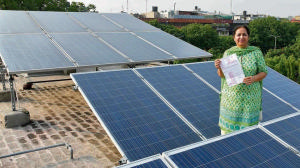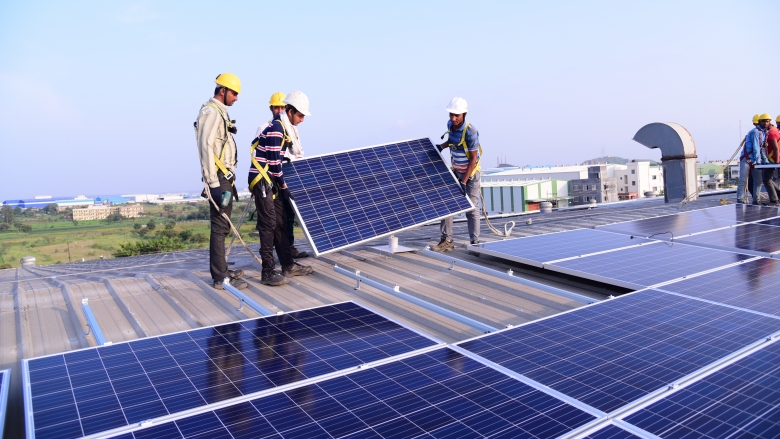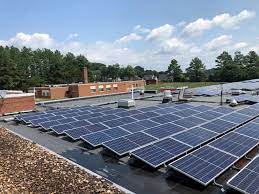- Six Reasons To Bring Millets To The Market!
- Hong Kong Court Makes Landmark Ruling Protecting Transgender Rights
- Substrate Promiscuity Of Fungi Generated Enzyme Laccase Shows Potential In Degrading Industrial Dye Effluents
- Union Minister Of Rural Development Holds A Meeting On ‘Cactus Plantation And Its Economic Usage’
- Ministry Of Tribal Affairs Organised One Day Mega Health Camp ‘Abua Bugin Hodmo-Our Better Health’ At Saraikela Kharsawan, Jharkhand
- Blue Flag Standards For Beaches In The Country
- India-Namibia Sign An MoU On Wildlife Conservation And Sustainable Biodiversity Utilization
- Hydrophobic Ingredients, In Combination With Obsolete Antibiotics, Can Counter Multidrug-Resistant Bacteria
- Promoting Cultivation Of Kala Namak Paddy
Going green? Turning solar a pipe dream for Chandigarh
Posted by: 2018-06-07 05:50:46 ,By Admin

It was more than two years back on May 18, 2016 that the modified building by-laws set the stage for transforming Chandigarh into a model solar city by making it compulsory for virtually all new and old residential, commercial and government buildings to install solar power plants. Two years on, the scheme is yet to take off. Reason: ignorance about the long-term monetary and ecological benefits of the plants that may seem high-priced at first, and some technical hitches.
Chandigarh Renewal Energy and Science & Technology Promotion Society (CREST), the nodal agency for this project, has so far set up Rooftop Solar Photo Voltaic (SPV) Power Plant Projects at nearly 260 government establishments, including 82 institutions, four hospitals, 14 colleges, 81 schools and about 78 houses with a capacity of nearly 17961 kWp (kilowatt peak).
Only 10% residences
But a senior CREST official rued that so far less than 10% of residential consumers have installed these plants. “While the new constructions can’t evade SPV plants as per the building bye-laws, we are yet to change the mindset of residents at large,” said the official. There are also technical reasons like trees covering rooftops, which come in the way of harnessing solar power.
Solar power systems are rated in kilowatts peak (kWp), the rate at which the SPV system produces energy at peak performance hours on a sunny day. One kWp system generates at least 10 units a day. A kanal house with four members consumes 30 units a day.
But the few residents who have opted for the solar plants are happy with the results.
Harjeet Kaur, a resident of Sector 44 who got an SPV plant on her 190 sq yards house in June 2017, beams as she says, “Ever since, my bill has been in the negative. This means that our panel is generating enough power to not only meet our requirement, but is also sending the rest of the power to the grid, which will be adjusted in our bills for days when we don’t have enough sunshine.” The plant, she said, also keeps them in a lower tariff slab. “Thanks to the solar power backup, the number of units we get from the grid supply also remain less.”
N S Randhawa, a retired police officer settled in Sector 38 West, opted for gross metering system nearly two years back.
“I send all the power generated to the grid. I am paying back for what I used to get from the Bhakra Nangal all these years. I came back to city in 2014 and opted for the Solar PV plant the moment it was mandated,” says Randhawa, who believes more people will take to the SPV plant if they knew that they would be able to recover the full cost of the plant within four to five years.
Listing other advantages of these plants, he said, “It requires little maintenance, has a shelf life of 25 years and is my contribution towards a green planet.”
Experts say solar plants also bring down the heat load of top floor by generating solar power to run electrical instruments in the house.
Gross versus net metering
Chandigarh consumers can opt for gross metering or net metering while installing SPV plants. In net metering, a consumer after generating and using solar power, can feed excess power into the grid to be adjusted in future billing cycle till the end of the settlement period, which happens twice on September 30 and March 31.
Under gross metering, the consumer can sell the entire solar power to the power grid through the distributing company, and get a solar tariff.
At present Ministry of Non-Renewable Energy is giving 30% of the cost of the SPV plant as subsidy. The single online platform, www.solarchandigarh.com not only ensures subsidy but also gets you all the regulatory clearances within a month. The list of empanelled vendors is also available on this website.
Of unkept green promises
1) Mandatory use of solar water heating system: The UT administration had made solar water heating mandatory in industries requiring hot water for processing; hospitals and nursing homes; hotels and banquet halls; jail barracks, canteens; housing complexes set up by group housing societies/housing boards; and all residential buildings built on a plot of size of 250 square yards and above within the limits of Chandigarh MC. All government buildings, schools and colleges were also supposed to instal it, but few have done this.
2) Use of a landfill site for solar power generation. The landfill at Daddu Majra has never been used for generating solar power.
3) The administration had also mandated SPV street lights in parks and gardens. Very few parks have these lights.
Read more: Click Here
You may like similar news

Rooftop Solar Programme extended till 31.03.2026
For information pertaining to National Portal please visit www.solarrooftop.gov.in The subsi...

Odisha Installs Solar Energy Panels in Govt Schools
Odisha Chief Secretary SC Mohapatra on Thursday inaugurated a solar based energy system in a governm...

Ministry of New and Renewable Energy to host “New Frontiers” program on Renewable Energy
The Ministry of New & Renewable Energy is conducting a program on Renewable Energy namely “New Fro...

Establishent of Bio-Gas Plants
The Ministry of New and Renewable Energy has been supporting installation of biogas plants in the co...

India & Denmark agree to work together on green fuels including green hydrogen
India & Denmark agreed to initiate joint research and development on green fuels including green hyd...









